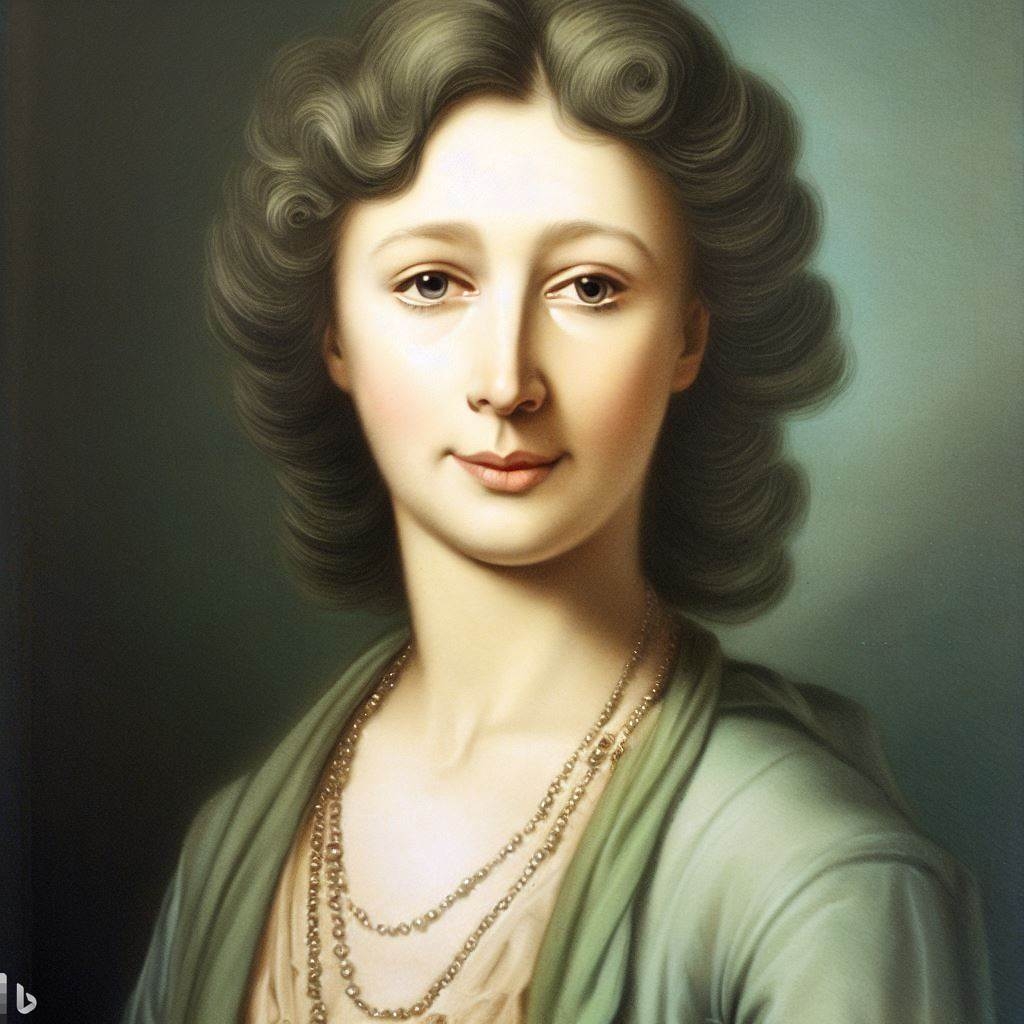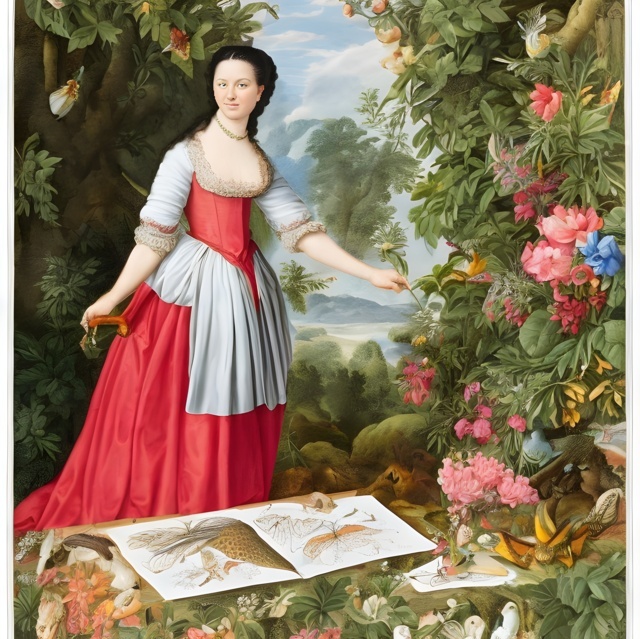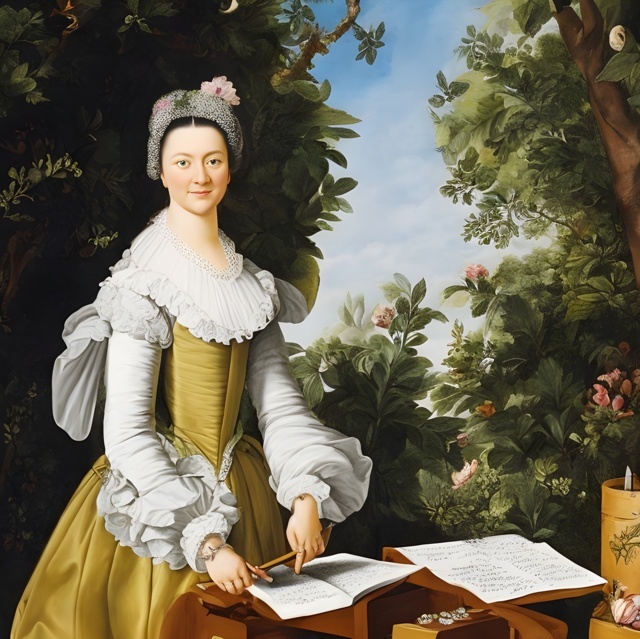A Pioneer of Entomology.
Maria Sibylla Merian was a German-born naturalist, scientific illustrator, and one of the pioneers of modern entomology. She was born on April 2, 1647, in Frankfurt am Main, Germany, and died on January 13, 1717, in Amsterdam, Netherlands. Merian was the daughter of a well-known artist and engraver, Matthäus Merian the Elder, and learned drawing techniques from her father, with which she painted flowers, fruits, birds, and insects. At the age of 13, she took up a hobby that she would pursue until the end of her life: collecting and raising caterpillars to observe their transformation into moths and butterflies.
Metamorphosis Insectorum Surinamensium
Merian’s book, Metamorphosis Insectorum Surinamensium (The Metamorphosis of the Insects of Suriname), was published in Latin and Dutch in 1705. The book included 60 large plates, each with an accompanying description. Merian etched the designs onto the plates herself then passed them to professional printmakers to be engraved for publication. Purchasers could buy the Metamorphosis with coloured or uncoloured plates. Merian also issued a small number of copies with counterproof illustrations. For these, a print with the ink still wet was pressed against another sheet, which was left with a faint impression of the image. These images were then hand-coloured. This ‘counterproof’ was in reverse orientation to the print and the same orientation as the original watercolour.
The Metamorphosis Insectorum Surinamensium was ground-breaking in many ways and had an enormous impact on European perception of the tropical New World, the life cycles of insects, and the art of scientific illustration. Merian’s work offers an insight into the exotic insect life of tropical South America, with lizards and snakes, colorful butterflies flying around flowering or fruiting plants, and huge caterpillars moving across the leaves. Some plates depict more than one species, as Merian observed that a plant was not the exclusive domain of only one. She successfully portrays on a large format a glimpse into the natural world that was previously unknown to Europeans.
Merian’s Contributions to Art and Science
Merian’s contributions to science are wide-reaching. Her detailed paintings, drawn from careful observation, recorded many new and occasionally bizarre creatures. For instance, Merian noticed that sometimes wasps emerged from the cocoon of a caterpillar that would normally turn into a moth or butterfly. She was one of the first people to record parasitic wasps. Merian’s research and paintings not only advanced our understanding of the natural world but also influenced the study of life on Earth. Carl Linnaeus, the scientist credited with developing the taxonomic structure—the system by which plants and animals are categorized—used many of Merian’s drawings and descriptions to name species he had never seen.
Merian’s work was not only scientifically significant but also artistically impressive. As an artist, her work had a strong influence upon scientific illustration. In addition to the accuracy and realism of her paintings, she was also known for her attention to detail and the beauty of her compositions. Merian’s illustrations were not only scientifically accurate but also aesthetically pleasing, and her work was highly regarded by her contemporaries.
Conclusion
Maria Sibylla Merian was a remarkable woman whose passion for nature and insects led her to combine art with science and be recognized as a naturalist, explorer, and one of the pioneers of modern entomology. Her book, Metamorphosis Insectorum Surinamensium, was a ground-breaking work that had an enormous impact on European perception of the tropical New World, the life cycles of insects, and the art of scientific illustration. Merian’s research and paintings not only advanced our understanding of the natural world but also influenced the study of life on Earth. Her illustrations were not only scientifically accurate but also aesthetically pleasing, and her work was highly regarded by her contemporaries.
References
– The Metamorphosis Insectorum Surinamensium – Royal Collection Trust. (2018, January 2). Retrieved from https://www.rct.uk/collection/themes/exhibitions/maria-merians-butterflies/the-queens-gallery-palace-of-holyroodhouse/the-metamorphosis-insectorum-surinamensium-
– Maria Sibylla Merian, the Woman Who Turned Science into Art – BBVA Openmind. (2018, April 2). Retrieved from https://www.bbvaopenmind.com/en/science/leading-figures/maria-sibylla-merian-la-mujer-convirtio-la-ciencia-arte/
– Maria Sibylla Merian (1647-1717) – Metamorphosis insectorum Surinamensium. (2018, January 2). Retrieved from https://www.rct.uk/collection/1085787/metamorphosis-insectorum-surinamensium
– Anna Maria Sibylla MERIAN. (n.d.). Retrieved from https://scientificwomen.net/women/merian-anna_maria_sibylla-67
– Maria Sibylla Merian: artist whose passion for insects changed science – The Guardian. (2013, April 2). Retrieved from https://www.theguardian.com/science/grrlscientist/2013/apr/02/maria-sibylla-merian-artist-insects-science
– Maria Sibylla Merian | Life, Facts, & Works – Encyclopedia Britannica. (2023, January 9). Retrieved from https://www.britannica.com/biography/Maria-Sibylla-Merian
– The Pioneering Work of Maria Sibylla Merian: Metamorphosis – Lloyd Library. (2017, August 17). Retrieved from https://lloydlibrary.org/exhibits/maria-sibylla-merian/
– Metamorphosis insectorum Surinamensium, 1705 – Maria Sibylla Merian – WikiArt.org. (2013, May 30). Retrieved from https://www.wikiart.org/en/maria-sibylla-merian/metamorphosis-insectorum-surinamensium-1705
– Maria Sibylla Merian’s Contributions to 17th-century Art & Science – Art Herstory. (2021, January 26). Retrieved from https://artherstory.net/curiosity-and-the-caterpillar/
– Metamorphosis insectorum Surinamensium — Dumbarton Oaks. (2023, March 2). Retrieved from https://www.doaks.org/resources/online-exhibits/maria-sibylla-merian/dissertatio-de-generatione-et
– https://www.getty.edu/news/maria-sibylla-merian-trailblazing-artist-scientist-of-the-seventeenth-century
Tags
Divi Meetup 2019, San Francisco
Related Articles
Unappreciated Greatness
Life and Legacy of Jahangir of the Mughal Empire. Jahangir ruled over one of the largest empires in human history during his lifetime, yet few people outside of South Asia have heard of him. I aim to shed light on the life and legacy of this remarkable figure,...
The Plague Doctor’s Diary
A Personal Account of the Turin Epidemic of 1656. I am writing this diary to record my experiences and observations as a plague doctor in Turin, the capital of the Duchy of Savoy, during the terrible epidemic that has afflicted this city and its surroundings since the...
The Timeless Beauty of Bustan
Unveiling the Secrets of Saadi Shirazi's Masterpiece.In the realm of Persian literature, few works have captured the essence of love, spirituality, and morality quite like Bustan (The Orchard) by Saadi Shirazi. This 13th-century masterpiece has left a lasting impact...
Stay Up to Date With The Latest News & Updates
Explore
Browse your topics of interest using our keyword list.
Join Our Newsletter
Sign-up to get an overview of our recent articles handpicked by our editors.
Follow Us
Follow our social media accounts to get instant notifications about our newly published articles.









